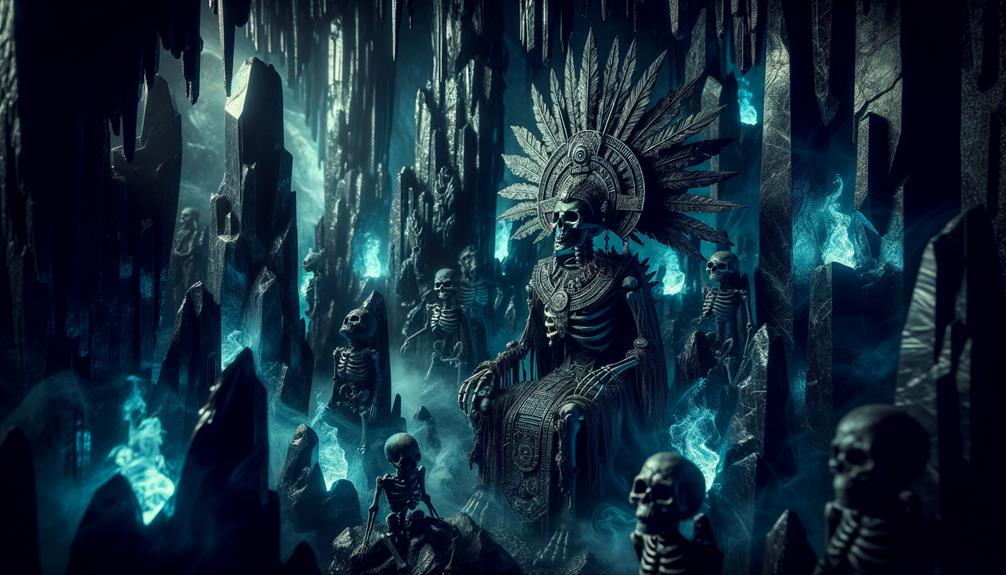Mictlantecuhtli, the skeletal Aztec deity associated with death, evokes an eerie yet compelling parallel to mythological figures like Hades or Anubis. These gods embodied distinct cultural perspectives on the afterlife, but Mictlantecuhtli stood apart, clad in owl feathers as a stark symbol of life's fragility. His presence wasn't solely rooted in fear but served as a poignant reminder of our mortality. Exploring Aztec rituals and legends surrounding his reign offers insights into how ancient societies grappled with the mysteries of death.
Origins and Etymology
Mictlantecuhtli's name, 'Lord of the Land of the Dead,' captures his pivotal role in Aztec beliefs. As the underworld's ruler, he embodied death and the journey beyond life. Crafted by the four Tezcatlipocas, Mictlantecuhtli represented the cold, dark north, the deceased's domain.
In Aztec mythology, Mictlantecuhtli's skeletal figure with skull features and hollow eye sockets symbolized death's inevitability. His open mouth, ready to receive setting stars, portrayed existence's cyclical nature and souls' passage into the underworld. This imagery reminded viewers of the natural order and each soul's ultimate journey.
While other myths featured underworld rulers, Mictlantecuhtli's skeletal depiction stood out. His connection to stars and earth highlighted his dominance over life's profound transition, anchoring him in the Aztecs' spiritual and cosmic narratives.
Attributes and Depictions
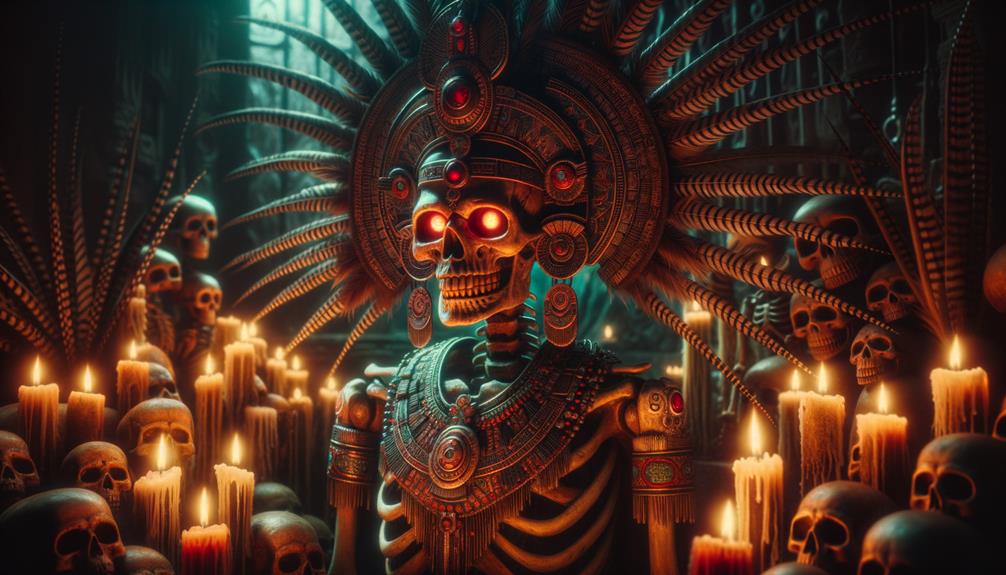
Mictlantecuhtli's striking depictions encapsulate his role as the formidable Aztec death deity. Towering at six feet, he manifests as a skeletal figure, blood-splattered with piercing eye sockets – a harrowing embodiment of mortality and the underworld. His headdress, adorned with owl feathers, and jewelry crafted from human bones accentuate his chilling presence.
Mictlantecuhtli's iconography holds profound symbolism, reflecting Aztec beliefs regarding life's impermanence. Three key elements define his representation:
- Skeletal Features: His bony frame and necklace of human eyes symbolize life's transience and the inescapable journey to the afterlife.
- Macabre Adornments: The owl feathers and bone jewelry connect him to the natural and supernatural realms.
- Staff with Skulls: This accessory underscores his dominion over life and death's cycle.
Through these motifs, Mictlantecuhtli personifies the Aztec creation myth's themes of death and regeneration, illustrating existence's delicate equilibrium.
Myths and Legends
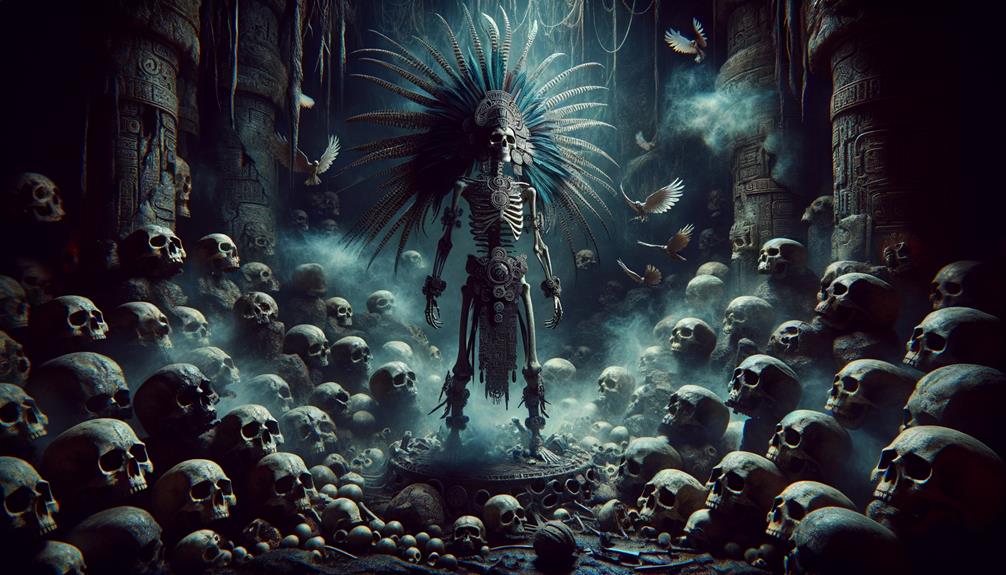
In Aztec folklore, Mictlantecuhtli stood as the mighty gatekeeper to the underworld, holding the scales between existence and the afterlife. As lord over Mictlan's shadowy realm, his role proved pivotal in the creation tale of humanity. The cunning Quetzalcoatl descended into Mictlan's depths, outwitting Mictlantecuhtli through guile and bravery to retrieve bones crucial for birthing mortals – a symbolic dance between life, death, and rebirth.
Mictlantecuhtli's dominion reached beyond myth into everyday Aztec customs. Rituals and offerings honored him, ensuring safe passage for departed souls navigating Mictlan's trials. Depicted as a skeletal figure in art and codices, his imagery remained an ever-present reminder of death's inevitability and the afterlife's mysteries.
Today, Mictlantecuhtli's legacy echoes during Día de Muertos celebrations. This deep-rooted tradition bridges past beliefs with modern Mexican culture, paying homage to the death deity through rituals steeped in ancient reverence. Mictlantecuhtli endures as a poignant symbol tying generations to their ancestral roots.
Worship and Rituals
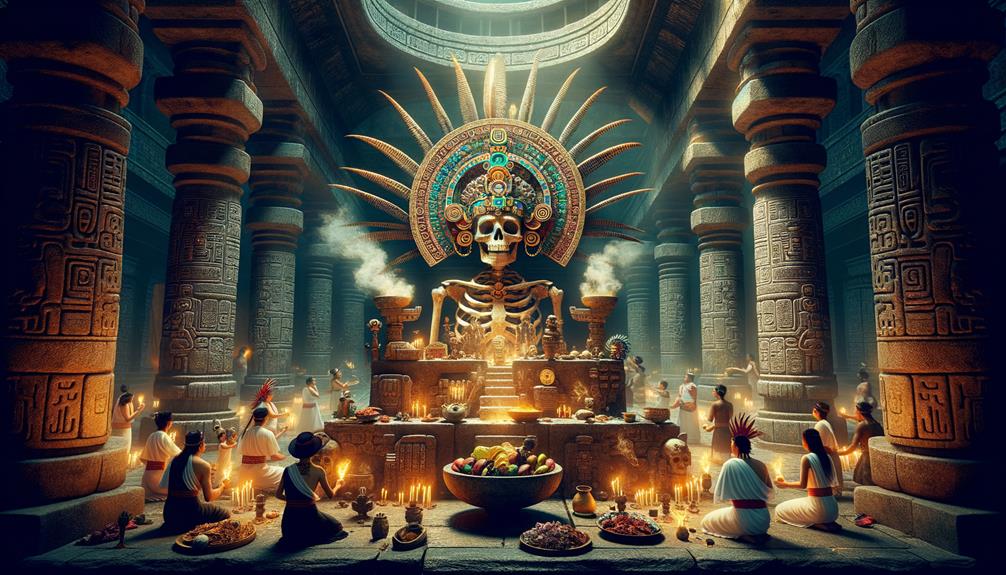
The Aztecs placed immense importance on appeasing Mictlantecuhtli, the underworld's ruler and god of death, through intricate rituals and sacrificial offerings. Failure to honor Mictlantecuhtli was believed to lead to an unfavorable afterlife journey.
Temples dedicated to this deity served as centers for ceremonies aimed at seeking Mictlantecuhtli's favor. Priests conducted ritualistic acts like human sacrifices, the highest form of tribute deemed necessary to placate the death god. Prayers, chants, and symbolic gestures accompanied offerings of food and valuables intended to sustain Mictlantecuhtli in the underworld.
Moctezuma II ramped up sacrificial practices, hoping to avoid suffering beyond the grave. However, Spanish colonization and the spread of Catholicism ultimately led to the decline of Mictlantecuhtli worship, bringing an end to these intense ceremonies. While the rituals faded, the legacy of this powerful Aztec deity endures as a significant part of their rich religious heritage.
Influence on Modern Culture
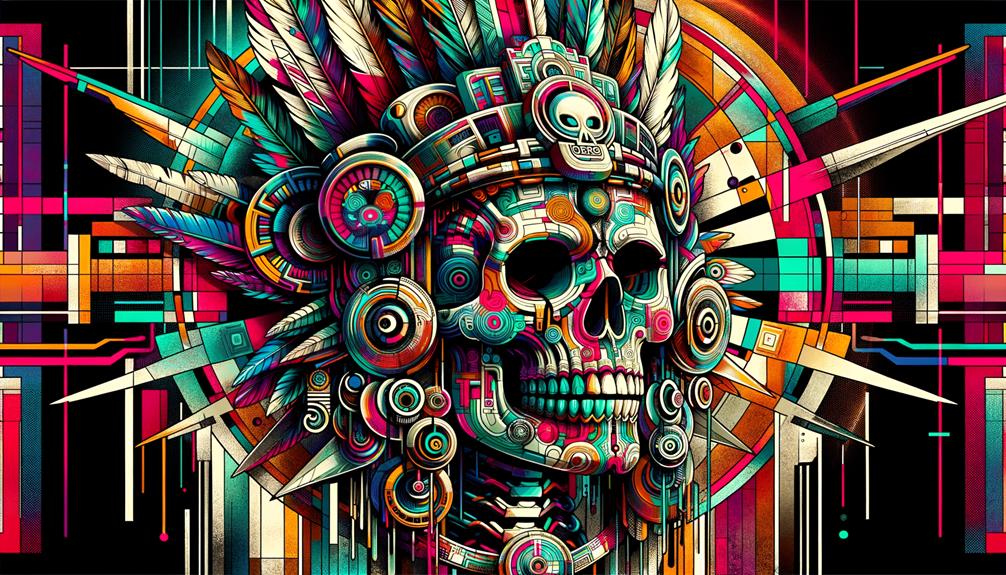
Mictlantecuhtli's legacy transcends ancient Aztec mythology, weaving through modern pop culture. In video games like Fortnite, the fearsome god manifests as the Mezmer skin, captivating gamers worldwide. Films like 'El Muerto' incorporate Nahuatl dialogue, honoring Mictlantecuhtli's roots while educating audiences.
This Aztec deity's significance extends beyond entertainment too. Scholarly works and art consistently examine his role as the lord of the dead. The animated film 'La leyenda de las Momias' further cements his contemporary relevance.
Mictlantecuhtli and his wife Mictecacihuatl remind us of creation and death narratives, bridging ancient worldviews with modern perspectives. Their enduring presence transcends time, continually shaping our cultural tapestry.
Frequently Asked Questions
What Is Mictlantecuhtli the God Of?
Mictlantecuhtli, the Aztec deity of death, guides souls through the nine realms of the underworld. This god represents life's cyclical nature, maintaining cosmic equilibrium. Fundamental to Aztec burial ceremonies, Mictlantecuhtli personifies the duality of existence – death nurturing rebirth.
Is Mictlantecuhtli Good or Bad?
Mictlantecuhtli transcends simplistic good or bad labels. Like mythological icons, his role represents the life-death cycle, upholding cosmic equilibrium in the hero's saga. He's a personification of nature's rhythms, not confined by moral extremes. His presence reminds us that existence defies convenient binaries; the story continues beyond mere judgments of right and wrong.
Who Is the Mexican God of the Underworld?
In Mexican folklore, the underworld ruler is Mictlantecuhtli. This deity guides souls through Mictlan's nine levels, symbolizing death's inevitability and life's cyclical nature. The god represents the journey after life, an inescapable transition within the natural order.
Who Was the Aztec Lady of the Underworld?
Mictecacihuatl, the Aztec goddess guiding souls in the afterlife, embodies the balance of life and death. Picture a skeletal figure – revered during Día de los Muertos (Day of the Dead) – ushering spirits through the underworld's mysteries. Her role transcends a mere spiritual escort, representing the cyclical nature of existence itself.

